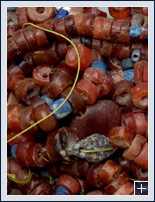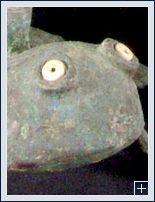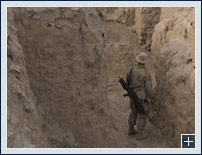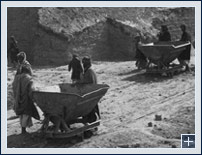Project Future
 [/kish/fieldmus/images/PF1-large.jpg]
[/kish/fieldmus/images/PF1-large.jpg]
Jewelry made of brightly colored exotic stones attests to the wealth of many of the individuals buried in the Kish cemeteries. Since these materials were not available in southern Mesopotamia, they had to be imported via trade networks that extended over considerable distances. Lapis lazuli, prized for its deep blue color, most likely came from northern Afghanistan while red carnelian came from Iran or, in some instances, from as far as the Indus Valley.
Kish East, Ingharra, Y Sounding, Burial Y687. Carnelian and lapis lazuli. Early Dynastic Period. Ashmolean Museum 1931.68
The ultimate goal of the Kish Project is to produce, over the next three years, a final site report covering the eleven seasons of excavation. The production of a report synthesizing the entirety of the excavations at Kish will be a complex undertaking, analogous to assembling a giant jig-saw puzzle using the pieces provided by the various databases and records left – but for the large part undigested and uninterpreted – by the excavators.
 [/kish/fieldmus/images/PF2-large.jpg]
[/kish/fieldmus/images/PF2-large.jpg]
Iraq is a land of rivers, canals, and marshes—all teeming with wildlife. Frogs like the one that forms the base of this stand, which might have supported a goblet, are a common sight, and must have been so in ancient times.
Kish East, Ingharra, Y Sounding, 6 m. below plain level. Copper alloy and stone. Early Dynastic Period. Field Museum 236392
Setting each artifact, building, and area of excavation in its fullest archaeological context and unraveling the archaeology and history of Kish as it emerges from that process will be a considerable challenge. To this end, a team of more than a dozen specialists in archaeology and related disciplines has been assembled to produce this report. Work will proceed area by area for the site. For each area the responsible staff member will examine the existing record of the work that was done, as it is documented in the few original reports and in the archival record. Using that material plus the work of other scholars, s/he will reconstruct the stratigraphy of that part of the site, producing drafts of plans and sections as necessary. Then the objects discovered there will be placed in their original archaeological contexts and studied for the information they reveal about a wide range of topics, including date(s) and function(s) of that portion of Kish and changes over both time and space. The whole area and its contents will be studied in the context of other discoveries in Mesopotamia and adjacent regions and compared and contrasted with that material to reveal what broader aspects of Mesopotamian culture it may elucidate.
 [/kish/fieldmus/images/PF3-large.jpg]
[/kish/fieldmus/images/PF3-large.jpg]
This photograph shows the present weathered condition of the Neo-Babylonian temple excavated by the Kish Expedition.
Image courtesy of an anonymous American soldier stationed in Iraq
As part of this project, the Kish collection for the first time will be studied using sophisticated scientific analytical techniques. Analytical instruments at The Field Museum provide substantial capabilities for the scientific study of archaeological materials. In-house facilities include a scanning electron microscope with energy dispersive spectrometer capabilities (SEM-EDS), a quadropole inductively coupled plasma mass spectrometer with laser ablation (LA-ICPMS), and a multicollector ICP mass spectrometer for high precision isotope analysis. Combined, these instruments allow for the examination and elemental characterization of mineral and metallic objects (SEM-EDS) and the proveniencing of archaeological and skeletal materials (ICPMS). In the case of the Kish materials, proposed types of analysis will involve the sourcing of trade goods, the study of the evolution of metallurgy in Mesopotamia, and the identification of the place of origin of certain presumably non-local individuals buried in the cemeteries of the city. Further work on light element stable isotopes, radiometry, and genetics, will, if necessary, be accomplished using specialized equipment available at partner institutions.
 [/kish/fieldmus/images/PF4-large.jpg]
[/kish/fieldmus/images/PF4-large.jpg]
Henry Field described the clearing of this temple in his book, The Track of Man:
"Slowly the outer walls of the base of a great temple were being uncovered. This was tedious work and resulted in nothing but a ground plan and photographs. Of all the treasures we had dreamed of finding in the temple, there came to light but five golden beads, which some hand had hidden in ancient times behind a brick in a high wall. What story lay behind them, of guilt or romance, we shall never know." (1953, p. 78)
Kish, Ingharra, Neo-Babylonian Temple. 1925-26 Season. Oxford Negative 508
The revisit of the Kish materials presents a unique opportunity to combine information gleaned from textual artifacts (e.g., cuneiform tablets) with data derived from scientific, stylistic, or other archaeological analysis. All of this interpretive work is essential if we wish to truly understand the nature and development of this early city, which occupied such a prominent place in the civilization of third millennium Mesopotamia—a civilization that was in many ways ancestral to all that has come after it down to the present day.
The Field Museum
The Field Museum, 'Project Future', The Field Museum's Kish Database Project, 2004-09, The Field Museum, 2025 [http://oracc.org/kish/fieldmus/KishPast,PresentandFuture/ProjectFuture/]